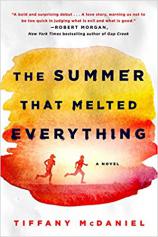The Summer That Melted Everything
Review
The Summer That Melted Everything
In the summer of 1984, evil came to a sleepy Ohio town. It came with a brutal heat wave and turned neighbor against neighbor, destroying one family who dared to love a stranger unconditionally. Tiffany McDaniel’s novel, THE SUMMER THAT MELTED EVERYTHING, is an ambitious and audacious debut. Lyrical and strange with a simmering then erupting danger, it follows the Bliss family as they and all the inhabitants of the town of Breathed lose their innocence and fall from grace.
Fielding Bliss is just 13 when his father, with a letter published in the newspaper, invites the devil to Breathed, a town nestled in the Appalachian foothills. Autopsy Bliss, a successful and passionate lawyer and a man of faith, wanted to understand and confirm the evil in those he prosecuted. He never anticipated that the devil would arrive in the form of a 13-year-old boy named Sal. Fielding meets Sal, a solemn, green-eyed black boy begging for ice cream on a suddenly hot day. Sal admits that he is called the devil, among other things, and arrived at Autopsy’s invitation. Fielding, who just sees a skinny and dirty kid in overalls, takes him home.
"THE SUMMER THAT MELTED EVERYTHING is inventive and provocative.... a meaty and relentlessly good story."
So begins a season of spiritual searching, social unrest, fatal accidents and violence in Breathed. At the center of the maelstrom is the Bliss family: Autopsy, Fielding, agoraphobic mother Stella, and the charming and talented eldest son Grand, who hides a great secret. The family takes Sal in without question, and as a search for his own family proves futile, he becomes their son and brother. But as the Bliss family incorporates Sal, and as Sal challenges them to be their more authentic selves, others in Breathed are far less welcoming. Sal is blamed for a series of incidents, and the question of his guilt or innocence brings the not-so-latent racism of the town to the surface. Leading a crusade against the devil is Elohim Grayson, a lonely man in perpetual mourning for his lost fiancé and Fielding’s former mentor. He and his followers take to gathering in the woods in revival-style meetings before planning to rid their community of Sal once and for all.
All the action of that terrible summer is remembered by a broken and angry Fielding 71 years later. But McDaniel spends the vast majority of her narrative in 1984. Fielding is an interesting figure --- as an innocent adolescent on the cusp of adulthood and witness to acts both confusing and horrific, and then as a bitter, traumatized and violent old man. At its best, THE SUMMER THAT MELTED EVERYTHING has the tone of a folksy mythology rife with symbolism and heavy with meaning, with characters struggling with moral choices, questions of identity, beliefs, love and loyalty. Breathed comes across like a 1950s town with splashes of ’80s neon and the specter of AIDS looming large. There is a playfulness to the novel, though its themes are dark and serious. McDaniel’s exploration of good and evil is nuanced and sophisticated, as she takes on the lure of temptation and the ease of quick judgment, as well as the choice to love openly and bravely.
THE SUMMER THAT MELTED EVERYTHING is inventive and provocative. Only occasionally does McDaniel lose control of her otherwise well-crafted prose by choosing style over substance. Overall, this is a meaty and relentlessly good story.
Reviewed by Sarah Rachel Egelman on July 29, 2016
The Summer That Melted Everything
- Publication Date: July 3, 2017
- Genres: Fiction
- Paperback: 320 pages
- Publisher: St. Martin's Griffin
- ISBN-10: 1250131677
- ISBN-13: 9781250131676





